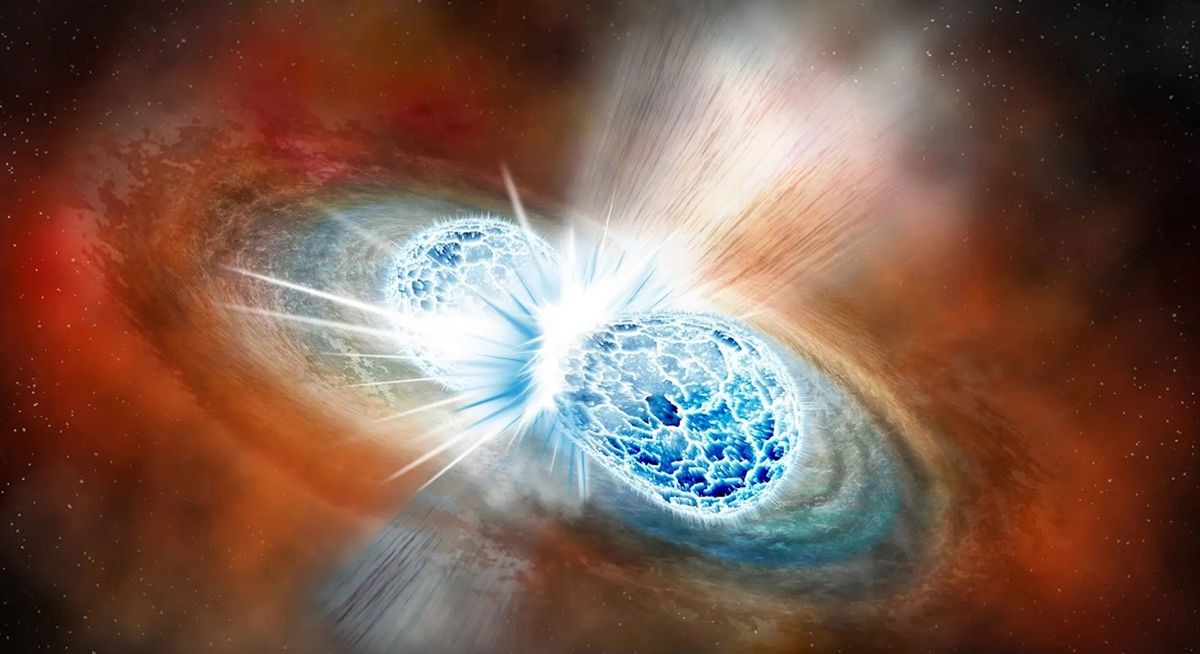Scientists have analyzed an unusually long blast of high-energy radiation, known as a gamma-ray burst (GRB), and determined that it originated from the collision of two ultradense neutron stars. And, importantly, this result helped the team observe a flash of light emanating from the same event that confirms these mergers are the sites that create elements like gold.
The observations, made using the James Webb Space Telescope (JWST) and the Hubble Space Telescope, allowed scientists to see gold and heavy elements forged, which could help us better understand how these powerful neutron star merger events generate the only environments in the universe turbulent enough to create elements heavier than iron, such as silver and gold which results in a flash of light called a kilonova.
"It was thrilling to study a kilonova as we had never seen before using the powerful eyes of Hubble and JWST," research team member and University of Rome astrophysicist Eleonora Troja told Space.com. "This is the first time we've been able to verify that metals heavier than iron and silver were freshly made in front of us,"
...
The most massive stars, around 7 to 8 times as massive as the sun, can forge elements all the way up to iron in their hearts. Once a stellar core is filled with this element, fusion ceases. That also cuts off the outward energy line that had been supporting the star against its own gravity for millions, or sometimes billions, of years. The cores of these massive stars then collapse under this crushing gravity, blowing away their outer layers in supernova explosions.
This collapse transforms the stellar core, crushing electrons and protons into a sea of flowing neutrons, particles found in atomic nuclei that very rarely exist "freely." Yet, in this sea, the neutrons are prevented from squeezing close together by a quantum principle called neutron degeneracy pressure, which can be overcome with enough mass to create a black hole. But sometime there isn't enough mass for a black hole to come into existence.
Those dead stellar cores without the mass to overcome degeneracy pressure are left as 12-mile (20-kilometer) wide bosies with masses between one and two times that of the sun. However, there is a way that neutron stars can contribute heavier elements than iron to the universe.
Not all neutron stars exist alone.
Some traverse the cosmos in neutron star binary systems, meaning they have another neutron star in its gravitational clutches. As these dead stars orbit each other, they set the fabric of space ringing with ripples called gravitational waves that gradually carry away angular momentum from the system.
This causes neutron stars to spiral together, emitting gravitational waves faster as time passes and "leaking" more angular momentum in tandem. Ultimately, the two collide and merge. This collision creates a gamma-ray burst and sends out a spray of neutron-rich material that help create the heavier elements of the periodic table.
Other atomic nuclei around these collisions grab the free neutrons via the rapid-neutron capture process, or r-process, and become briefly lived superheavy elements called "lanthanides." Those lanthanides then quickly decay into lighter elements (though elements still heavier than lead.) This decay causes the emission of radiation, light we see from Earth as a "kilonova." Thus, tracking the evolution of kilonovas can help follow the creation of elements like gold and silver.
"Neutron star mergers could give rise to an ideal environment to extensively synthesize heavy elements, which is currently beyond artificial creation," Yang said. "Studying neutron star mergers helps us rewrite the obscure chapters of nucleosynthesis."
...
More:

James Webb Space Telescope finds neutron star mergers forge gold in the cosmos: 'It was thrilling'
"This is the first time we've been able to verify that metals heavier than iron and silver were freshly made in front of us."
There's gold in them thar novas!
